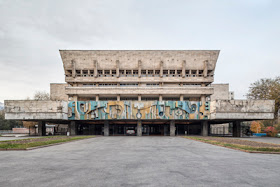 |
| Moskvich 403E |
Founded by Georgian businessman and collector Giorgi Mamulashvili, this private museum boasts over 30 models of superbly restored, iconic Soviet vintage cars and motorcycles. It is one of the world's largest collections of Soviet vehicles.
Museum director, Rezo, guides visitors with fascinating tales of each and every car - in Russian, English and Georgian. Many have been sourced from former Soviet republics.
Post WWII, the Soviets competed not just in the space race, but on every level to demonstrate the superiority of their political system.
Soviet engineers modelled cars from European and American designs - at times these were blatant copies, at other times cool elements from a foreign model were incorporated into a Soviet car.
In the 1960s, private car ownership was on the rise and it was decided to build a "people's car". For reasons of cost-efficiency, they chose to sign a licence agreement with a foreign company and produce the car on the basis of an existing, modern model. Several options were considered, including Volkswagen, Ford, Peugeot, Renault and Fiat.
 |
| Volga GAZ M21 |
Stavropol was renamed Togliatti to commemorate Palmiro Togliatti, the Italian politician and leader of the Italian Communist Party.
The first VAZ-2101, named Zhiguli within the Soviet Union and Lada for export markets, was a rugged model to handle the poor roads, Ladas were also designed to be easily maintained by owners as there were few auto-repair shops.
The museum includes models of the much-feared KGB cars, that could accelerate incredibly fast to nab people off the streets, or follow foreign diplomats! There are Zaporozhets, Chaikas and Pobedas. All the vehicles are registered and participate in various regional festivals. I happily spent two hours there. (More photos below.)
How to visit:
The museum is in an industrial complex and can be a tad difficult to find. Catch the metro to Varketili and then a taxi. The museum is about 5 kms away via the Kakheti Highway Service Rd - ask the driver to wait. (Better still invite the driver to the museum). Round trip taxi fare and waiting time was about US$12.
Address: Auto Museum Street #7 next to Grigol Lortkipanidze street
Telephone: +995 599 54 56 28 (Keep it handy so the driver can call if lost).
Opening hours: Daily except Mondays, from 11:00 - 18:00.
Entrance fee: GEL 10 (about US$3.50)
Related posts:
Georgia: State Silk Museum, Tbilisi
A 19th century Georgian Painter in Uzbekistan - Gigo Gabashvili
The Blue Tablecloths of Georgia: New Life of an Old Tradition
Georgia: Soviet Modernist Mosaics from 1960 to 1990









